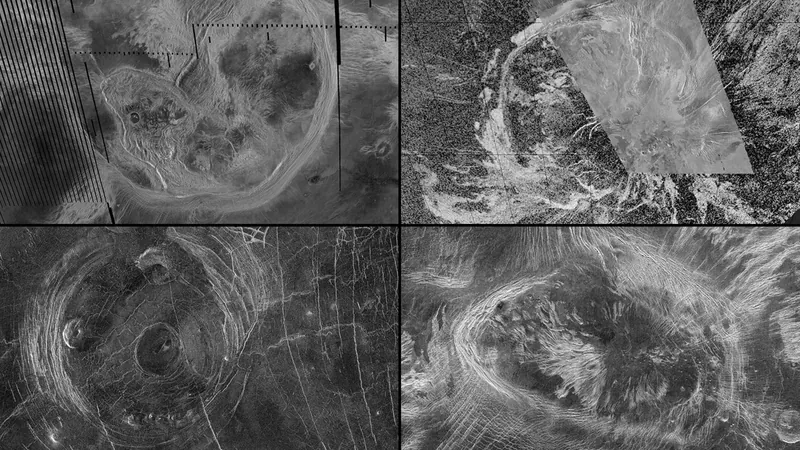
Venus Unveils Its Secrets: Ongoing Geological Activity Discovered!
2025-05-19
Author: Arjun
A groundbreaking study has revealed unexpected signs of geological activity on Venus, suggesting the planet's enigmatic surface is still evolving even today. These findings, centered around giant circular features known as "coronae," could not only reshape our understanding of Venus but may also provide tantalizing insights into Earth's ancient past.
Coronae are immense, oval-shaped structures spanning from dozens to hundreds of miles in width. They are thought to emerge as hot plumes of molten rock from deep within the planet push against its outer shell, termed the lithosphere. Picture a slow-motion bubble of magma pressing upward, warping and cracking the crust above it.
These colossal geological wonders, framed by intriguing rings of fractures, are scattered across Venus, offering scientists a breathtaking glimpse into the planet's inner dynamics. Anna Gülcher, a planetary scientist from the University of Bern, emphasized the significance of these features, stating, "We can now confidently assert that there are likely various and ongoing active processes driving their formation."
Interestingly, while coronae are absent from Earth's current landscape, they may have once existed during our planet's youth, before the establishment of plate tectonics. Lead author Gael Cascioli from the University of Maryland and NASA's Goddard Space Flight Center remarked, "Studying these features on Venus can enhance our understanding of both worlds."
By integrating gravity and topography data, this innovative research reveals crucial insights into the subsurface processes currently shaping Venus's exterior. The research team employed a 3D computer model to simulate hot material movement beneath the surface, akin to a virtual experiment revealing the planet's unseen workings.
The data gathered by NASA's Magellan spacecraft in the early 1990s played a pivotal role in their findings. The gravity data, which measures the pull of gravity at various points on the surface, was key. Denser materials exert a stronger gravitational pull, allowing researchers to uncover hidden plumes of hot, less dense material rising from the depths of Venus—information that surface maps alone could not provide.
In their analysis of 75 coronae, the team found that 52 displayed evidence of these underground forces still in action, indicating that tectonic activity might be more widespread on Venus than previously recognized. They postulate that various tectonic processes are shaping the surface around the coronae.
Possible mechanisms include subduction-like activity, where parts of the planet's outer shell are pushed down into heated depths as hot plumes rise, akin to interactions between tectonic plates on Earth. Additionally, lithospheric dripping—where cooler, heavier portions of the surface sink into the hotter mantle—could explain the tectonic activity supporting the coronae. There's also the possibility that plumes beneath a thicker crust trigger volcanic activity above.
Regardless of the specific processes at play, these discoveries suggest that Venus is geologically active in diverse and intricate manners, offering researchers clues about planetary tectonics in the absence of Earth-like plate boundaries — and perhaps illuminating Earth’s more dynamic earlier history.
While this extensive study is significant, it relies on older data. The upcoming VERITAS mission promises to enhance understanding, as it will provide higher-resolution images that could clarify these results. Suzanne Smrekar, a JPL planetary scientist and VERITAS principal investigator, highlighted, "The VERITAS gravity maps of Venus will improve resolution by a factor of two to four, revolutionizing our perception of Venus's geology and its implications for early Earth." Scheduled to launch in 2031, VERITAS is set to unlock even more secrets of our celestial neighbor.




 Brasil (PT)
Brasil (PT)
 Canada (EN)
Canada (EN)
 Chile (ES)
Chile (ES)
 Česko (CS)
Česko (CS)
 대한민국 (KO)
대한민국 (KO)
 España (ES)
España (ES)
 France (FR)
France (FR)
 Hong Kong (EN)
Hong Kong (EN)
 Italia (IT)
Italia (IT)
 日本 (JA)
日本 (JA)
 Magyarország (HU)
Magyarország (HU)
 Norge (NO)
Norge (NO)
 Polska (PL)
Polska (PL)
 Schweiz (DE)
Schweiz (DE)
 Singapore (EN)
Singapore (EN)
 Sverige (SV)
Sverige (SV)
 Suomi (FI)
Suomi (FI)
 Türkiye (TR)
Türkiye (TR)
 الإمارات العربية المتحدة (AR)
الإمارات العربية المتحدة (AR)